
Knee Injury Prevention For Gymnasts
Leave a CommentGymnastics is a fun and popular sport for young children and adolescents. As athletes progress in competition, the level and difficulty of skills increases as well as the risk for injury.
One of the body parts where we see injury more often in gymnasts is the knee. The knee is the body’s main shock absorber for jumping and landing. For example, the landing impact on various skills can increase the ground reaction force to several times greater than a gymnast’s body weight.1,2
Common Knee Injuries for Gymnasts
Due to these high forces at the knee, injury in the form of micro-trauma or injury to ligaments and tendons is possible. Here are some common knee injuries that can occur for gymnasts:
- Osgood Schlatter’s disease
This is common in growing gymnasts between ages 9-16. It is categorized as pain and inflammation at the bony prominence below the knee cap; this is where the quadriceps muscle tendon attaches. Many children with this condition have experienced a recent growth spurt and may be involved with sports with lots of running and jumping, including gymnastics. Osgood Schlatter’s disease occurs as a result of repetition as opposed to a traumatic event.
- Patellar tendinitis (“jumper’s knee”)
Pain can be distinguished in this condition to the patellar tendon which is located just below the kneecap. The patellar tendon is at risk for tendinopathy due to high repetition and overuse that can occur during sports with a lot of running and jumping – such as gymnastics. This tendinitis can be more likely if the gymnast is landing with their knees going forward past the toes.
- Patellar subluxation or dislocation
These injuries to the patella can occur if the kneecap goes out of its tracking path but comes back in on its own (subluxation), or if the kneecap goes out and must be realigned by a medical professional (dislocation). Stress on the muscles and soft tissue surrounding the patella can lead to subluxation and dislocation. Knee braces and physical therapy can help with these injuries.
- ACL, MCL, PCL injury
These knee ligament injuries can result when a gymnast lands “short” or is over rotated when tumbling, dismounting or vaulting. These injuries are usually a traumatic event. A pop may be heard or felt followed by knee swelling. An MRI is performed for diagnosis. Surgery is often recommended for ACL tears, while MCL and PCL injuries may be able to be treated conservatively with bracing and physical therapy.
- Meniscus injury
The meniscus is inside the knee joint and acts as a great shock absorber in the knee and provides stabilization. However a large and forceful impact can cause the meniscus to tear, leading to pain and swelling of the knee. Meniscus injuries can be treated conservatively or with surgery depending on the severity.
Ways to Decrease Risk of Knee Injury in Gymnasts
Even though gymnasts are at risk for a variety of knee injuries, there are things gymnasts can do to decrease their risk of knee injury. Use these tips to help protect your knees:
- Strengthen your legs
Strengthening the muscles of the legs is a huge component of injury prevention for gymnasts. Gymnasts gain their power and push from their legs, therefore these muscles all need to be strong. It is important to strengthen all the muscles including the glutes, quads and hamstrings. When performing strengthening exercises, make sure you are not rushing through the exercises – slower speeds are actually more challenging for the muscles and require better control.
- Core strengthening
Gymnasts need core strength to do all of the amazing tumbling skills. The core also supports them with jumping and landing mechanics. Planks are a great core exercise that require no equipment to perform.
- Stretching
Flexibility is very important for gymnastics. Equal stretching of both legs, even if you have a dominant side for skill performance, is important for the gymnast especially in terms of injury prevention. Read “Stretching Safely in Gymnastics” for more information.
- Warm up & Cool Down
Performing a proper warm up prior to practice or competition is helpful for injury prevention as well as performing a cool down to help the muscles recover after activity. A warm up should incorporate movements that you will be performing during practice such as lunges, jogging and arm circles. A cool down may also involve full body movements, but is a good time for more prolonged stretching.
- Landing and jumping properly
Proper jumping and landing mechanics help to place the knee in an ideal position for shock absorption. When landing, land toes first, then ball of foot, then heels as if rolling through the foot. Also push the butt backward as if sitting into a chair to prevent knees from going forward past the toes for both landing and jump take off.
Listen to Your Body
Pain is the body’s alarm system and should be paid attention. Ice after practice for general aches and pains can help with swelling and soreness of the knees. If you are a gymnast with an injury, find your closest Athletico to request an appointment.
The Athletico blog is an educational resource written by Athletico employees. Athletico bloggers are licensed professionals who abide by the code of ethics outlined by their respective professional associations. The content published in blog posts represents the opinion of the individual author based on their expertise and experience. The content provided in this blog is for informational purposes only, does not constitute medical advice and should not be relied on for making personal health decisions.
References:
1. Seegmiller, Jeff & Mccaw, Steven. (2004). Ground Reaction Forces Among Gymnasts and Recreational Athletes in Drop Landings. Journal of athletic training. 38. 311-314.
2. Kulig K, Fietzer AL, Popovich JM. Ground reaction forces and knee mechanics in the weight acceptance phase of a dance leap take-off and landing. J Sports Sci. 2011;29(2):125-31

